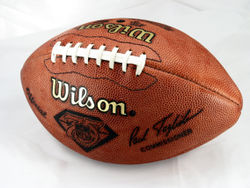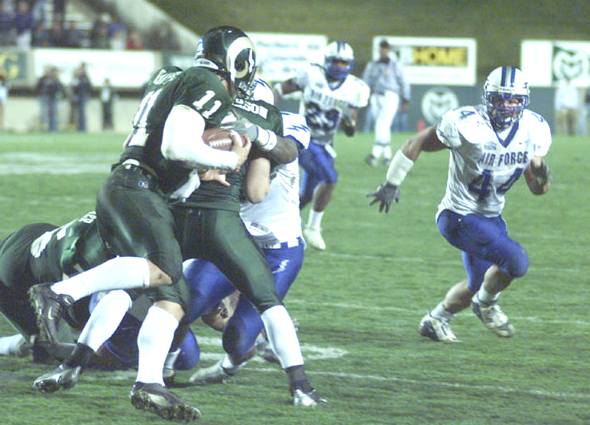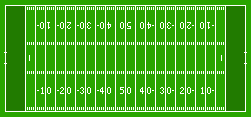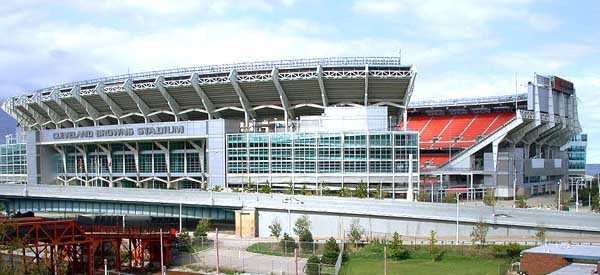|
AMERICAN FOOTBALL
|
||
|
HOME | BIOLOGY | FILMS | GEOGRAPHY | HISTORY | INDEX | MUSIC | SOLAR BOATS | SPORT | SPONSORS |
||
|
American football, known in the United States and Canada simply as football, is a competitive team sport. The object of the game is to advance the football towards the opposing team's end zone and score points. The ball can be advanced by carrying the ball, or by throwing or handing it from one teammate to the other. Points can be scored in a variety of ways, including carrying the ball over the goal line, throwing the ball to another player past the goal line or kicking it through the goal posts on the opposing side. The winner is the team with the most points when the time expires and the last play ends.
An American football has a pointed oval or vesica piscis shape and large stitches along one side
Outside of the United States and Canada, the sport is usually referred to as American football (or sometimes as gridiron or gridiron football) to differentiate it from other football games, especially association football (soccer) and rugby football. American football evolved as a separate sport from rugby football in the late 19th century. Arena football is an invented variant of American football. Canadian football, which also descended from rugby, is closely related to the American sport with a few key differences; the word "football" in Canada can mean American football or Canadian football depending on context.
Popularity
Since the 1960s, football has outranked baseball as the most popular spectator sport in the United States. The 32-team National Football League (NFL) is the most popular and only major professional American football league. Its championship game, the Super Bowl, is watched by nearly half of US television households, and is also televised in over 150 other countries. Super Bowl Sunday has become an annual ritual in late January or early February. Football is also the most watched sport on television in the US.
The NFL also operates a developmental league, NFL Europe, with 6 teams based in European cities.
College football is also extremely popular throughout the U.S., especially in markets not served by an NFL team. Several college football stadiums seat more than 100,000 fans -- which regularly sell out. Even high school football games can attract five-figure crowds, especially in hotbeds like Western Pennsylvania, Nebraska, Ohio, Georgia and Texas. The weekly autumn ritual of college and high-school football -- which includes marching bands, cheerleaders and parties (including the ubiquitous tailgate party) -- is an important part of the culture in much of smalltown America. It is a long-standing tradition in the United States (though not universally observed) that high school football games are played on Friday, college games on Saturday, and professional games on Sunday (with an additional professional game on Monday nights--see Monday Night Football). It is often said of an outstanding college football player that he is likely to "be playing on Sundays one day", meaning that he is a good pro prospect.
Certain fall and winter holidays--most notably Thanksgiving, Christmas, and New Years' Day--have traditional football games associated with them.
Football is also played recreationally by amateur club and youth teams (e.g., the Pop Warner little-league programs). There are also many "semi-pro" teams in leagues where the players are paid to play, but at a small enough salary that they generally must also hold a full-time job.
Colorado State University player runs with the ball as an Air Force Academy player lines up a tackle
Pro football is played only in the United States and in the above-mentioned NFL Europe league. The sport is popular as an amateur activity in Mexico and American Samoa and to a lesser extent in Japan, Europe and Australia.
A very similar sport, Canadian football, is widely played in Canada. Many universites there have teams compete annually for the Vanier Cup and there is a professional league, the Canadian Football League.
Organized football is played almost exclusively by men and boys, although a few amateur and semi-professional women's leagues have begun play in recent years.
The rules of American football
The object of American football is to score more points than the opposing team within a set time limit.
Field and players
Football is played on a rectangular field 120 yards (110 metres) long by 53 1/3 yards (49 metres) wide. The longer boundary lines are sidelines, while the shorter boundary lines are end lines. Near each end of the field is a goal line; they are 100 yards apart. A scoring area called an end zone extends 10 yards beyond each goal line to each end line.
Yard lines cross the field every 5 yards, and are numbered from each goal line to the 50-yard line, or midfield (similar to a typical rugby league field). Two rows of lines, known as hash marks, parallel the side lines near the middle of the field. All plays start with the ball on or between the hash marks.
At the back of each end zone are two goal posts (also called uprights) that are 18.5 feet apart. The posts are connected by a crossbar 10 feet from the ground. Successful kicks must go above the crossbar and between the uprights. (At professional, college, and some high school fields, the uprights and crossbar are attached by a curved bar to a post outside the field of play, to reduce the chance of players running into the supports. Many high schools, though, use an H-shaped structure located behind the endlines.)
Each team has 11 players on the field at a time. However, teams may substitute for any or all of their players, if time allows, during the break between plays. As a result, players have very specialized roles, and almost all of the 53 players on an NFL team will play in any given game. Thus, teams are divided into three separate units: the offense, the defense and the special teams (see below). In the NFL, players' jersey numbers are distributed according to a strict system (e.g. quarterbacks always wear between 1-19).
The numbers on the field indicate the number of yards to the nearest end zone
Game duration
A standard football game consists of four 15-minute (typically 12 minutes in high school football) periods (called quarters), with an intermission (called halftime) after the second quarter. The clock stops after certain plays; therefore, a game can last considerably longer (often more than three hours in real time). If an NFL game is tied after four quarters, the teams play up to another 15 minutes. In an NFL overtime game, the first team that scores wins; if neither team scores, the game is a tie. College overtime rules are more complicated and are described at Overtime (sport). Advancing the ball
Advancing the ball in American football resembles the six-tackle rule and the play-the-ball in rugby league football. The team that takes possession of the ball (the offense) has four attempts, called downs, to advance the ball 10 yards towards their opponent's (the defense's) end zone. When the offense gains 10 yards, it gets a first down, or another set of four downs to gain 10 yards. If the offense fails to gain a first down (10 yards) after 4 downs, it loses possession of the ball.
Except at the beginning of halves and after scores (see Kickoffs and free kicks below), the ball is always put into play by a snap. All players line up facing each other at the line of scrimmage (the position on the field where the play begins). One offensive player, the center, then passes (or "snaps") the ball between his legs to a teammate, usually the quarterback.
Players can then advance the ball in two ways:
A play or down ends, and the ball becomes dead, after any of the following:
Officials blow a whistle to notify all players that the play is over.
At all times, players and fans must be aware of the sequence of downs and the distance to a new first down. When a team has a first down, the scoreboard or television screen flashes "1st and 10" — that is, first down and 10 yards to go. If the team gains three yards on the first play, for example, the next down will be "2nd and 7." If the team gains 6.5 yards on the next play the scoreboard may say "3rd and inches." If a team gains a first down within the ten yard line then the scoreboard or television reads "(the down) and goal." Changes of possession
The offense maintains possession of the ball unless one of the following things happens:
Scoring
A team scores points by the following plays:
Kickoffs and free kicks
Each half begins with a kickoff. Teams also kick off after scoring touchdowns and field goals. The ball is kicked from a kicking tee, which is made from one's own 30-yard line in the NFL and from the 35-yard line in college football. The other team's kick returner tries to catch the ball and advance it as far as possible. Where he is stopped is the point where the offense will begin its drive, or series of offensive plays. If a kick returner does not want to run with the ball, he has the option to signal for a "fair catch" by waving his hands in the air before the catch. He will then be allowed to catch the ball without being tackled. If the kick returner catches the ball in his own end zone, he can either run with the ball, or elect for a touchback by kneeling in the end zone. The receiving team can starts its offensive drive from its own 20-yard line. A touchback also occurs when the kick goes out of the end zone. Punts and turnovers in the end zone can also end in touchbacks.
After safeties, the team that gave up the 2 points puts the ball into play with a punt or placekick from its own 20-yard line.
A halfback leads fellow backs through an agility drill
Penalties
Rule violations are punished with penalties. Most penalties result in moving the football either towards the endzone in the case of a defensive penalty, or away from the endzone in the case of an offensive penalty. Some defensive penalties give the offense an automatic first down. In addition, if a penalty gives the offensive team enough yardage to gain a first down, the first down is automatically given. If a penalty occurs during a play, an official throws a yellow flag near the spot of the foul. When the play is over, the team that did not commit the penalty has the option of taking either the penalty or the result of the play. For example, say a defensive player commits an offsides penalty on first down by passing the line of scrimmage before the snap, and the offense gains eight yards on the play. The team with the ball has the option of taking the penalty and repeat the first down with five yards to go, or declining the penalty and scrimmaging with 2nd and 2.
Some common penalties
The players
As noted above, most football players have highly specialized roles. At the college and NFL levels, most play only offense or only defense.
Offense
Not all of these types of players will be in on every offensive play. Teams can vary the number of wide receivers, tight ends and running backs on the field at one time.
Defense
Special teams
The units of players who handle kicking plays are known as special teams. Two important special-teams players are the punter, who handles punts, and the placekicker or kicker, who kicks off and attempts field goals and extra points. It is rare, but not unheard of, for these two positions to be filled by the same player.
Basic football strategy
To some fans, the chief draw of football is the chess game that goes on between the two coaching staffs. Each team has a playbook of dozens to hundreds of plays. Plays are the directions for what the players should do on a down. Some plays are very safe; they are very likely to get a few yards, but not much more than that. Other plays have the potential for long gains but a greater risk of a loss of yardage or a turnover.
Generally speaking, rushing plays are less risky than passing plays. However, there are relatively safe passing plays and risky running plays. To fool the other team, there are passing plays designed to look like running plays and vice versa. There are many trick or gadget plays, such as when a team lines up like it is going to kick and then tries to run or pass for a first down. Such high-risk plays are a great thrill to the fans when they work. However, they can spell disaster if the opposing team realizes the deception and acts accordingly.
It has been suggested that football is the closest sport that strategically resembles real war. It is by far the most popular sport in the American military. In fact, the United States Military Academy, the United States Naval Academy, and the United States Air Force Academy each field football teams that participate in Division I-A of the NCAA. Army and Navy have a particularly historic rivalry.
Physicality of the game
American football is a collision sport. To stop the offense from advancing the ball, the defense must tackle the player with the ball by knocking him down. As such, defensive players must use some form of physical contact to bring the ball-carrier to the ground, within certain rules and guidelines. Tacklers cannot kick, punch or trip the runner. They also cannot grab the face mask of the runner's helmet, lead into a tackle with their own helmet, or lift the ball carrier up off his feet and drop him. Despite these and other rules regarding unnecessary roughness, most other forms of tackling are legal. Blockers and defenders trying to evade them also have wide leeway in trying to force their opponents out of the way. Quarterbacks are regularly hit by defenders coming on full speed from outside the quarterback's field of vision.
The high level of physical contact in football makes it more dangerous than other major American team sports. To compensate for this, players must wear a good deal of special protective equipment, such as a padded plastic helmet, shoulder pads, hip pads and knee pads. These protective "paddings" were introduced decades ago and improved ever since to help minimize lasting injury to players. However, increased padding has allowed players to make harder hits; though there are fewer minor injuries in American football than in other football sports, serious injuries such as spinal cord injuries are much more common.
Despite protective equipment and rule changes to emphasize safety, injuries remain very common in football, due to its physical nature. Twenty-five football players, mostly high schoolers, died from injuries directly related to football from 2000-2004, according to the National Center for Catastrophic Sport Injury Research. Concussions are common, with an estimated 62,000 suffered every year among high school players according to the Brain Injury Association of Arizona. [1]. It is common to see injuries in the game, and deaths are not unheard of. The game is particularly risky when played by amateurs without proper gear, such as is common amongst Americans in backyards and parks across the country.
Some have criticized American football as a violent sport. American football is indeed quite physical in comparison to other major American team sports, such as basketball and baseball. Tackle football is often banned in American schoolyards in favor of touch football, which uses two-hand touching instead of tackling; or flag football in which a player is "tackled" when an opponent pulls a flag off a belt attached to the player's waist. School physical education classes often use the "two-hand touch" version of the game, leaving the tackles to the school's official after-school sports program which can provide the appropriate gear and supervision.
The level of physical aggression and risk of injury has also made football less appealing to females, as they generally lack the muscle and body mass to compete without serious risk. The tackle nature of football also tends to favor the largest and strongest players, along with the fastest. The average weight of players in the NFL has increased in recent years.
All these factors have brought the sport into controversy in the past few decades, joining the group of other "violent" and thus controversial sports such as dodgeball, wrestling, hockey, and boxing. Critics argue that these sports emphasize size, physical strength, and brute force, and also that they breed aggression and unhealthy competitive attitudes in children. Others argue that such sports teach sportsmanship and teamwork, and though contact sports are all violent to some degree, they always emphasize skill and strategy over mere belligerence.
Cleveland football stadium
Development of the game
Both American football and soccer have their origins in varieties of football played in the United Kingdom in the mid-19th century, and American football is directly descended from rugby football.
Rugby was first introduced to North America in Canada, brought by the British Army garrison in Montreal which played a series of games with McGill University. Both Canadian and American football evolved from this point. For an in-depth overview of the differences and similarities of Canadian football and American football see: Comparison of Canadian and American football
American colleges spearheaded the growth of football. The first inter-collegiate football game was played between Rutgers and Princeton Universities on November 6, 1869. The game was won by Rutgers (6-4) although "The game, which bore little resemblance to its modern-day counterpart, was played with two teams of 25 men each under rugby-like rules, but like modern football, it was 'replete with surprise, strategy, prodigies of determination, and physical prowess,' to use the words of one of the Rutgers players." - Rutgers Football
American football in its current form grew out of a series of three games between Harvard University and McGill University of Montreal in 1874. McGill played rugby football while Harvard played the Boston Game, which was closer to soccer. As often happened in those days of far from universal rules, the teams alternated rules so that both would have a fair chance. The Harvard players liked having the opportunity to run with the ball, and in 1875 persuaded Yale University to adopt rugby rules for their annual game. In 1876 Yale, Harvard, Princeton, and Columbia formed the Intercollegiate Football Association, which used the rugby code, except for a slight difference in scoring.
In 1880 Walter Camp introduced the scrimmage in place of the rugby scrum. In 1882 the system of downs was introduced to thwart Princeton's and Yale's strategy of controlling the ball without trying to score. In 1883 the number of players was reduced, at Camp's urging, to eleven, and Camp introduced the soon standard arrangement of a seven-man offensive line with a quarterback, two halfbacks, and a fullback.
On September 3, 1895 the first professional football game was played, in Latrobe, Pennsylvania, between the Latrobe YMCA and the Jeannette Athletic Club. (Latrobe won the contest 12-0.).
By the 1890s interlocking offensive formations such as the flying wedge and the practice of teammates physically dragging ball-carrying players forward had made the game extremely dangerous. Despite restrictions on the flying wedge and other precautions, in 1905 eighteen players were killed in games. President Theodore Roosevelt informed the universities that the game must be made safer. To force them to respond to his concerns, he threatened to pressure Congress to make playing football a federal crime.
In 1906, two rival organizing bodies, the Intercollegiate Rules Committee and the Intercollegiate Athletic Association, met in New York; eventually they agreed on several new rules intended to make the game safer, among them the addition of a neutral zone between the scrimmage lines and a requirement that at least six players from each team line up on them. The most far-reaching innovation they considered, though, was the legalization of the forward pass. This was very controversial at the time, much derided by purists. As an alternative means of opening out the play, Walter Camp would have preferred widening the field; but representatives from Harvard pointed to recently constructed Harvard Stadium, which could not be widened, and the forward pass was adopted; it has come to shape the whole history of American football, as opposed to its cousins around the world.
In 1910, after further deaths, interlocking formations were finally outlawed; and in 1912 the field was changed to its current size, the value of a touchdown increased to 6 points, and a fourth down added to each possession. The game had achieved its modern form.
Problems in football
Injuries are more common in American football than in many other sports, although rule changes made in the past 90 years (for instance, the elimination of "horse-collar tackles") have gradually lowered the rates of injuries. In addition, protective equipment has become better - for example, the optional leather helmets introduced during the 1890s have been replaced (in several stages) by required high-tech padded plastic helmets with bars protecting the face. Modern field turf is seen as another danger-adding element in the game of football. Turf offers less "give" than grass, and can exert much greater forces on the players' bodies. While it guarantees a certain state of the play field, and enables players to run faster, it has also been shown to cause more injuries, most notably ankle injuries.
More recently, the use of steroids and the extent thereof has become an object of debate in professional, college, and even high school football leagues.
Another problem with football is that it is an expensive sport. The specialized helmets, uniforms, and pads can cost hundreds of dollars. There is a widespread perception that football teams based in schools and public recreational leagues consume far more than their fair share of the sports budget, although sales of tickets to college (and to some extent high school) football games often make it a revenue-producing sport.
Leagues, Organisations and Associations
United States
Football is played at a number of levels in the United States. These include the following:
Internationally
American football is also played in many nations around the world. These include:
Alternate Rulesets
Other kinds of American football with modified or derived rules:
Non-current Leagues
Professional leagues that no longer exist:
LINKS and REFERENCES
A - Z SPORTS INDEX
LINKS:
A taste for adventure capitalists
Solar Cola - a healthier alternative
|
||
|
This
website
is Copyright © 1999 & 2006 NJK. The bird |
||
|
AUTOMOTIVE | BLUEBIRD | ELECTRIC CARS | ELECTRIC CYCLES | SOLAR CARS |




